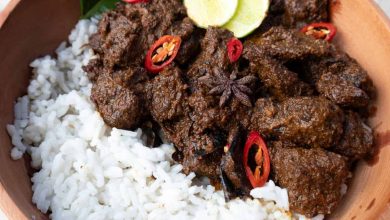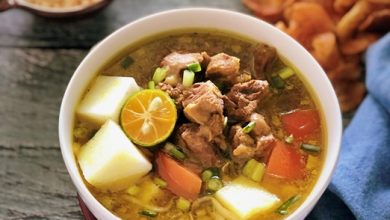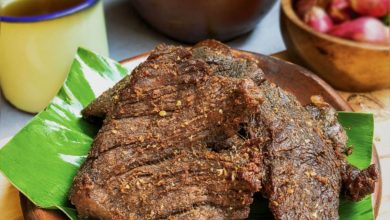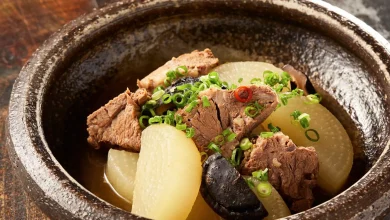Introduction
Welcome to Love With Recipes, your ultimate destination for authentic, flavorful dishes from around the world. Today, we delve into the heartwarming world of Indonesian cuisine with a traditional recipe that embodies comfort and richness—Sop Kaki Sapi. This Indonesian beef trotter soup has been cherished across generations for its deep, savory broth infused with aromatic herbs and spices. The process of preparing Sop Kaki Sapi involves careful selection of ingredients, precise cooking techniques, and a deep appreciation for traditional flavors. Whether you are a seasoned home cook or a curious food enthusiast, this comprehensive guide will provide you with all you need to create an authentic and soul-satisfying bowl of Sop Kaki Sapi from scratch. Prepare to indulge in a culinary journey that combines cultural heritage, culinary techniques, and a love for hearty, flavorful food.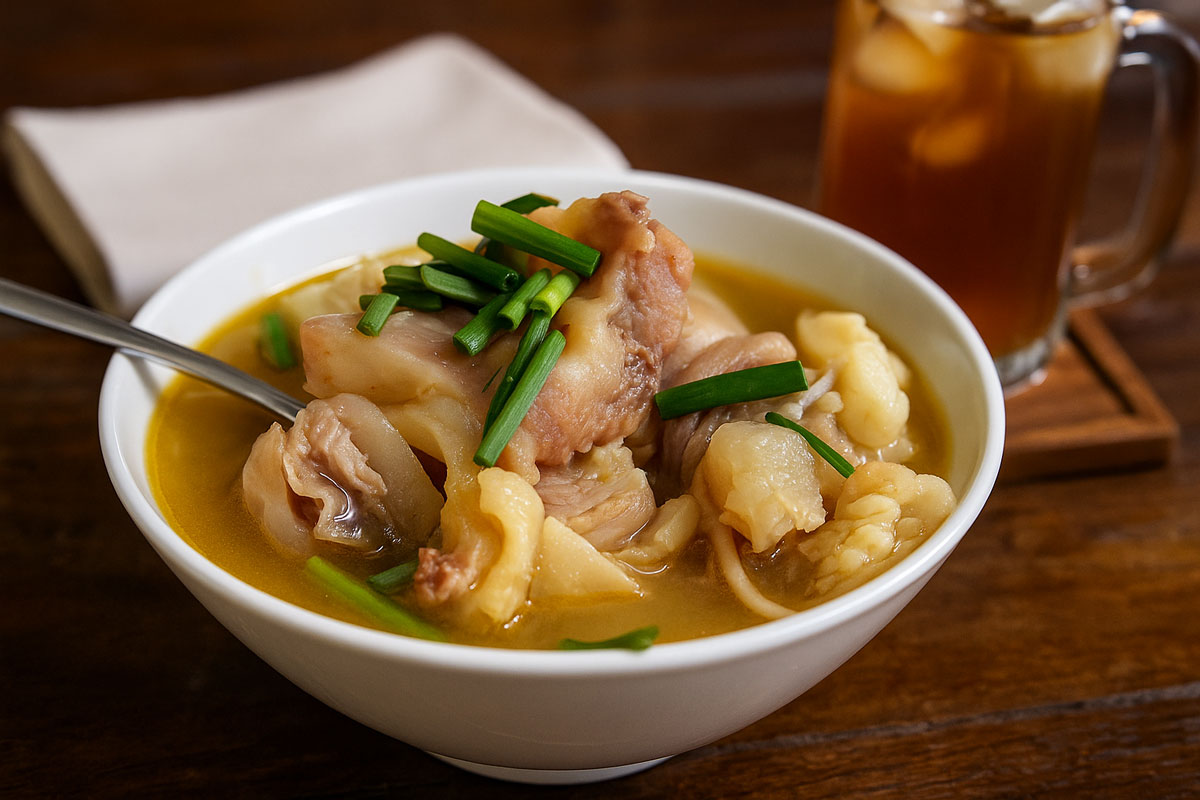
Time
- Preparation Time: 30 minutes
- Cooking Time: 1 hour
- Total Time: Approximately 1 hour 30 minutes
Needed Equipment
- Pressure cooker or large heavy-bottomed pot
- Cutting board
- Sharp chef’s knife
- Peeler (optional)
- Wooden spoon or ladle
- Fine mesh strainer or slotted spoon
- Measuring spoons
- Kitchen tongs
- Serving bowls
- Soup ladle
Tags
Indonesian cuisine, Traditional soup, Beef trotters, Comfort food, Hearty meal, Aromatic herbs, Family recipe, Authentic Indonesian dish
Serving Size
This recipe yields approximately 4 to 6 servings, depending on portion size. It is perfect for sharing among family or friends, and leftovers can be stored for subsequent meals.
Difficulty Level
Intermediate — requires familiarity with basic cooking techniques such as boiling, simmering, and handling meats. The process involves multiple steps but is straightforward with clear instructions.
Allergen Information
This dish contains beef and may include traces of soy or gluten depending on seasonings used. Always verify ingredients if you have allergies or sensitivities. It is naturally gluten-free if no soy sauce or gluten-containing seasonings are added.
Dietary Preference
Traditional Sop Kaki Sapi is not suitable for vegetarians or vegans due to its beef content. However, it can be adapted for keto or paleo diets by avoiding added seasonings with sugar or soy-based ingredients.
Course
Main Course, Soup, Comfort Food
Cuisine
Indonesian
Ingredients
In Detail — Ingredient Quantities and Descriptions
| Ingredient | Quantity | Description/Notes |
|---|---|---|
| Beef trotters (pork trotters if preferred) | 1 kilogram (about 2.2 lbs) | Pre-cooked until tender, ideally in a pressure cooker to save time and ensure tenderness |
| Garlic | 2 cloves | Fresh garlic, lightly crushed or minced to release flavor |
| Ginger | 1 thumb-sized piece (~2 inches) | Fresh ginger, sliced or smashed for infusion |
| Lemongrass | 1 stalk | Bruised or smashed to release aroma, optional but recommended |
| Kaffir lime leaves | 4 leaves | Fresh or dried, adds citrusy aroma and flavor |
| Ground black pepper | To taste (~1/2 teaspoon) | Freshly ground preferred for maximum flavor |
| Salt | To taste (~1 teaspoon) | Adjust according to preference and seasoning |
| Seasoning (optional) | As desired | Can include soy sauce, fish sauce, or MSG for enhanced umami |
Instructions
Preparing the Beef Trotters
Begin by thoroughly cleaning the beef trotters. Rinse them under cold running water, scrubbing gently to remove any residual blood, dirt, or impurities. For enhanced flavor and tenderness, pre-cook the trotters in a pressure cooker or large pot. If using a pressure cooker, add the trotters and enough water to cover them. Cook under high pressure for approximately 30 minutes until the meat is tender but not falling apart. Alternatively, simmer in a large pot for 2 to 3 hours, skimming off any foam or impurities that rise to the surface. Once cooked, set aside the trotters, reserving the cooking liquid if desired for other uses. Allow the trotters to cool slightly before handling, then cut into manageable pieces if not already pre-cut. This step ensures easier handling during the final cooking stages.
Building the Soup Base
Next, prepare the soup broth. Fill a large pot with approximately 8-10 cups of water, enough to comfortably cover all ingredients once added. Bring this to a rolling boil over medium-high heat. Once boiling, carefully add the pre-cooked beef trotters into the water. It’s important to note that you should not use the broth from the initial pressure cooking of the trotters, as it may contain impurities or overly concentrated flavors that could affect the final taste.
Aromatics and Flavor Infusion
Prepare the aromatics to enhance the flavor profile of the soup. Lightly crush the garlic cloves using the side of a knife or a garlic press to release essential oils and maximize flavor extraction. Slice or smash the ginger to facilitate its infusion into the broth. Bruise the stalk of lemongrass by hitting it with the back of a knife or a rolling pin; this action releases the essential oils and aromatic compounds. Add the garlic, ginger, lemongrass, and kaffir lime leaves directly into the boiling water. Stir gently to distribute evenly. Add freshly ground black pepper to taste, which adds a subtle spiciness and depth to the broth.
Seasoning and Final Touches
Season the broth with salt, starting with about one teaspoon and adjusting as needed. If you prefer a more complex flavor, add optional seasonings such as soy sauce, fish sauce, or a pinch of MSG. These ingredients should be added sparingly to avoid overpowering the natural flavors of the beef and herbs. Allow the soup to simmer uncovered for about 10 minutes, or until the flavors meld and the broth is heated through. During this time, taste the broth and adjust the seasoning accordingly, adding more salt or seasonings if necessary.
Serving and Garnishing
Once the soup is ready, turn off the heat and remove the aromatics if desired, or leave them in for a more intense flavor. Serve the Sop Kaki Sapi hot, ladled into bowls. It pairs beautifully with steamed rice or traditional Indonesian side dishes. Garnish with additional kaffir lime leaves or chopped fresh herbs like cilantro or scallions for added freshness. For an authentic touch, serve with a side of sambal or chili sauce for those who enjoy a spicy kick.
Preparation Tips
- Use high-quality fresh or frozen beef trotters for the best flavor and tenderness.
- Pre-cooking the trotters in a pressure cooker significantly reduces cooking time and ensures tender meat.
- Crushing the garlic and ginger releases more aromatic compounds, enriching the broth.
- Bruising the lemongrass enhances its aroma; avoid chopping it into small pieces to prevent it from dispersing too much in the soup.
- Adjust seasoning gradually; it’s better to start with less and add more as needed.
- Remove aromatics before serving if you prefer a cleaner broth, or leave them in for a more intense flavor profile.
Nutritional Information
| Nutrient | Per Serving (approximate) |
|---|---|
| Calories | 320 kcal |
| Protein | 25 grams |
| Fat | 15 grams |
| Carbohydrates | 8 grams |
| Sodium | 900 mg |
| Fiber | 2 grams |
| Vitamins & Minerals | Rich in calcium, iron, and vitamin C from herbs |
Tips and Tricks
- Enhance Flavor: Add a splash of lime juice or a dash of fish sauce for extra umami and brightness.
- Texture Control: For a thicker broth, mash some of the cooked trotters or simmer longer to reduce the liquid slightly.
- Herb Variations: Incorporate other herbs such as bay leaves, coriander seeds, or turmeric for additional layers of flavor.
- Meal Prep: Prepare the broth in advance and store it in the refrigerator; reheat and add fresh herbs before serving.
Add-ons
- Hard-boiled eggs
- Fried shallots or garlic chips
- Chopped fresh scallions or cilantro
- Sambal or chili sauce for heat
- Steamed rice or rice noodles
Side Dishes
Serve Sop Kaki Sapi alongside traditional Indonesian side dishes such as:
- Steamed jasmine rice or pandan rice
- Tempeh or tofu fried with sambal
- Satay skewers with peanut sauce
- Gado-gado salad with peanut dressing
- Indonesian vegetable stir-fry (sayur lodeh)
Improvements and Variations
- Vegetarian Version: Replace beef trotters with mushroom or eggplant for a vegetarian adaptation, and use vegetable broth enhanced with umami-rich seasonings.
- Spice Level: Adjust the spiciness by adding chili peppers, sambal, or chili powder to cater to heat preferences.
- Broth Richness: Incorporate star anise, cinnamon sticks, or cloves during simmering for a more complex, aromatic broth.
Save and Store
Leftover Sop Kaki Sapi can be cooled to room temperature and stored in an airtight container in the refrigerator for up to 3 days. For longer storage, freeze in freezer-safe containers for up to 2 months. To reheat, gently warm on the stove over low heat, ensuring it reaches a safe temperature. Fresh herbs and seasonings should be added after reheating to maintain vibrant flavors.
FAQ
Can I use pork trotters instead of beef?
Yes, pork trotters are an excellent alternative and will produce a similar rich, gelatinous broth. Adjust cooking times accordingly, as pork trotters may require slightly longer simmering for tenderness.
Is it necessary to pre-cook the trotters?
Pre-cooking ensures tenderness and reduces the overall cooking time. It also helps remove impurities, resulting in a clearer broth. If you prefer, you can cook the trotters directly in the soup from raw, but expect a longer cooking process.
How can I make this dish spicier?
Add chopped fresh chili peppers, chili paste, or extra chili powder during the seasoning stage. Adjust gradually to taste.
Can I make this dish vegetarian?
Traditional Sop Kaki Sapi relies on beef trotters, but a vegetarian version can be created using mushrooms or eggplant, along with vegetable broth and umami-rich seasonings like soy sauce or mushroom broth.
Conclusion
Sop Kaki Sapi from Indonesia is a celebration of culinary heritage, combining tender, flavorful meat with aromatic herbs and spices to create a comforting, nourishing bowl. Its versatile nature allows for various adaptations, making it suitable for different dietary needs and flavor preferences. Whether served as a main dish for family gatherings or a warming meal on a cold day, this soup exemplifies the richness of Indonesian cuisine. Remember, the key to an authentic and delicious Sop Kaki Sapi lies in the quality of ingredients, patience during simmering, and love infused into every step. We invite you to explore this recipe and make it your own, sharing the warmth of Indonesian flavors with loved ones.
References
- Indonesian Food & Cooking by Sri Owen – A comprehensive guide to traditional Indonesian recipes.
- Seriouseats.com – Tips on cooking beef trotters and aromatic broth techniques.



